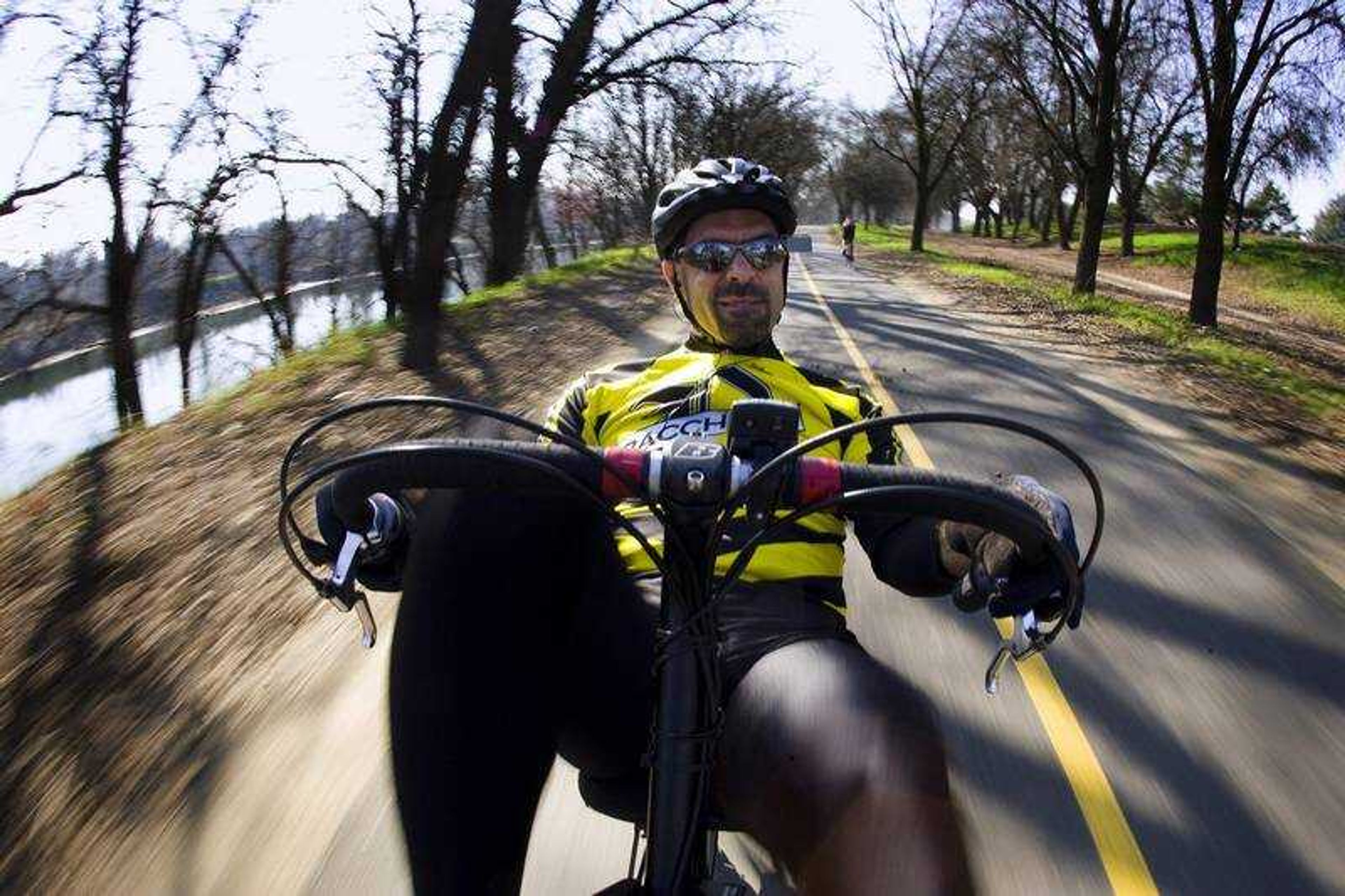Bent into shape: More cyclists turn to recumbent bikes
As with many cyclists who have chosen to "get 'bent" — that is, to ride those funky, laid-back recumbent bikes instead of conventional upright models — Gary Souza made the switch because of injury. Back? Neck? Shoulder? "No," the 45-year-old Sacramento, Calif., resident said. "It was, like, a more sensitive area. I use the term 'crotchasarus area."...
As with many cyclists who have chosen to "get 'bent" — that is, to ride those funky, laid-back recumbent bikes instead of conventional upright models — Gary Souza made the switch because of injury.
Back? Neck? Shoulder?
"No," the 45-year-old Sacramento, Calif., resident said. "It was, like, a more sensitive area. I use the term 'crotchasarus area."
An avid cyclist who put in high mileage on his standard diamond-frame bike featuring a fancy titanium cutaway saddle, Souza in 1997 sustained a serious rupture near his prostate. His doctor told him to stay off the bike for a year.
"Riding is a near-spiritual experience for me," Souza said. "I'm thinking, 'I can't not ride for that long.'"
He had seen a few quirky souls, mostly aging baby boomer men, on the road, pedaling away on what seemed like a modified Barcalounger. These guys always drew snickers from the serious cyclists. But Souza was desperate to ride.
"Riding a recumbent often is social suicide," Souza said, laughing. "I kind of secretly rode the recumbent to stay in shape."
When Souza's doctor gave him the go-ahead to resume riding a real bike, Souza felt uncomfortable in the standard hunched-over position. That tingling in his hands was back. Shoulders pinched. His head over the handlebars felt awkward.
"After 100 yards, I turned and went home," he said. "I sold all three conventional bikes that I owned at the time."
And he's been laid-back ever since.
If you think you're seeing more recumbent cyclists such as Souza in the bike lanes, you may not be mistaken.
Though experts estimate recumbents make up only about 20,000 of the 15 million bikes sold yearly in the United States, anecdotal evidence suggests they are increasingly becoming an option for a growing demographic — baby boomers, mostly male, who want the speed of a high-performance bike without the back-wrenching side effects from their Lance Armstrong fantasy life.
Cycle Werx manager Dustin Gross said the store in Cape Girardeau only carries a few and they don't sell often.
"It's a niche market," Gross said.
Speed and comfort are why most riders choose to get 'bent.
At one end of the recumbent spectrum is Daniel Runyon, a 34-year-old registered nurse from Carmichael, Calif.
"It's speed," he said, mentioning the recumbent's low-to-the-ground aerodynamic design. "I like to go fast. My average cruising speed is easily 4 mph faster than on an upright frame. I mean, that's the difference between driving an SUV and a sports car."
At the other end is Ted Sommer, a 49-year-old scientist from Davis, Calif.
"Back problems," he said, succinctly. "A physical therapist told me I was going to have to give up long rides. Think of it this way: Try sitting at your desk, on a little wedge of a seat, hunched forward for several hours. Wouldn't you rather sit back with plenty of room?"
Recumbent users often speak with evangelical fervor. But they also know the bike's design has limitations. Long-wheelbase bikes measure up to 7 feet, making them hard to transport on a rack. They steer differently. Hills are more challenging. And the price tag (a decent "starter" bike runs about $1,000) is steeper.
"Most normal bikes are $300 to $400," Gross said. Recumbent bikes "are nontraditional so they're not mass produced."
And, as Eric Warp, a 51-year-old from Fair Oaks, Calif., warns, you must learn how to ride all over again.
"It's a different set of muscle groups, mostly the quads," he said. "It takes a good six weeks of riding to get used to the musculature."
You also aren't immune to injury on a recumbent.
"An inadequately reclined seat back — less than about 30 degrees from vertical — and no spring suspension can cause pain and numbness in the coccyx (tailbone) ... brought on by bouncing the full weight of the torso on the tailbone," said longtime Sacramento recumbent rider Peter Kosal, a retired engineer in his 60s.
Yet, even riders who alternate between uprights and recumbents admit they simply have more fun being laid-back.
Jon Baker, a 46-year-old cardiothoracic surgeon who lives in Fair Oaks, Calif., is a veteran Ironman triathlete and participant in the Race Across America, swears by his Bacchetta Titanium Aero, which sells for $3,000 to $7,000.
"Last year, when I got back from the Ride Across America, I decided I will never do that again on an upright bike," he said. "I had an open wound on my bum that has left permanent scars down there."
Gross disagreed, saying while they may be fun to ride occasionally, "I wouldn't have it for my primary bike."
Southeast Missourian features editor Chris Harris contributed to this report.
Connect with the Southeast Missourian Newsroom:
For corrections to this story or other insights for the editor, click here. To submit a letter to the editor, click here. To learn about the Southeast Missourian’s AI Policy, click here.









